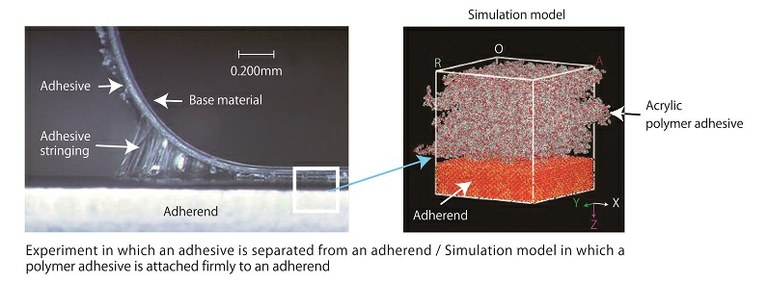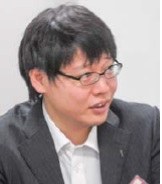5th Visiting Our Graduates
Shoichiro Saito
Technology Section 4, Functional Design Technology Center, Corporate Research and Development Division, Corporate Technology Sector, Nitto Denko Corporation
Majored in computational physics in the Graduate School of Engineering at Osaka University and received his doctorate for research into first-principles calculations of the interfaces between semiconductors and insulators. Subsequently joined Nitto Denko Corporation.
|  |
|---|
In Search of Simulations that Can Be Applied to Product Development
In this fifth installment of “Visiting Our Graduates,” we visited Shoichiro Saito at Nitto Denko Corporation. We asked him about topics ranging from the research he conducted in his university days to the adhesive simulations he is performing with the use of the K Computer.
Research and Development Involving Use of the K Computer
Konishi : Let me begin by asking you about the research and development you're working on at Nitto Denko.
Saito : Nitto Denko is a well-known manufacturer of adhesive tapes, polymer membranes, medical products, information materials and so on. My job can be roughly divided into two activities. One is to resolve problems that are directly related to product development. When we're developing various products, we need to resolve technical issues that impede the development process as quickly as possible using numerical simulation technologies. My other main task is to develop molecular simulation technologies that are expected to be needed in future products development efforts. In my department, we handle everything from micro molecular simulations to macro continuum simulations.
Konishi : So you're in charge of micro calculations such as electronic structure calculations?
Saito : Yes, I use electronic structure calculations as well. I'm also trying to use molecular dynamics methods to perform simulations for diffusion and other types of systems where movement is crucial.
Konishi : I understand you're also using the K Computer. What type of research are you conducting?
Saito : I used the K Computer to perform simulations for an adhesive made up of several million atoms. As adhesives are composed of polymers made up of an enormous number of atoms, it's necessary to use a high-performance supercomputer in order to perform simulations for all atoms on a spatial scale that is close to reality. If you perform the simulation as a model of a system that is closer to reality than is possible with conventional methods, you can hope to get knowledge that will be helpful in developing real-world materials. It was from that perspective that we began a research project on the topic using the K Computer. In this project, I'm primarily in charge of modeling the molecular structure of the adhesive. As the simulation software, I'm using a highly parallelized molecular dynamics program for large-scale molecular systems.
Konishi : What kind of results have you gotten?
Saito : I conducted a simulation of the separation of the adhesive from the adherend, and I learned that the behavior of the force produced at the time of separation was qualitatively similar to the behavior observed in experiments.
Konishi : Have you had trouble with anything when performing simulations?
Saito : To begin with, when I actually tried executing the program on the K Computer, an error occurred and the program stopped. The environment that we use on the computers at Nitto Denko is different from that of the K Computer, so transferring the program to the K Computer as is doesn't work. I spent quite a bit of time to port the program to the K Computer architecture. I was in charge of everything from modeling the molecular structure of the adhesive through model stabilization. The molecular model of the adhesive included not only the degree of freedom to adapt to the number of atoms but also the degree of freedom for the interactions between molecules and so on. So I had a hard time finalizing metastable structures.
Things Learned in Student Days: The Basic Rules for Communicating Correct Information
Konishi : You earned your degree at the Graduate School of Engineering at Osaka University. What kind of research did you do there?
Saito : Beginning in my fourth year of undergraduate school, I conducted research into first-principles calculations , working under Assistant Professor Tomoya Ono (the present post: Associate Professor in University of Tsukuba). From a laboratory studying electronic devices in the same department, Dr.Ono received a request for an analysis of the interfacial properties of a germanium using first-principles calculations. At the time, there was interest in germanium as a possible substitute for silicon. I was a fourth year undergraduate student at the time, and I was put in charge of the analysis. I worked on it until I graduated with my graduate school degree. In graduate school, my primary research was not limited to the interfacial properties of germanium materials; I also studied semiconductor-insulator interfaces.
Konishi : What things that you learned during your student days are you applying in your current job?
Saito : When you consider properties using electronic structure theory, you're able to deepen your understanding of many of the phenomena you observe in experiments, and I think my knowledge is helpful in that regard. I'm able to use what I learned in my student days, so I think I'm taking advantage of the things in my arsenal.
Konishi : What kind of things did you learn through your graduate school activities?
Saito : I learned a lot about logical sentence construction from Dr. Ono. Starting with the basics, I was taught how to communicate correct information and not pretend like I know more than I do, not only in academic papers but in emails and daily conversation as well. That's something we need in order to be a full-fl dged member of society as well, and I make an effort to do that even now.
Konishi : What was your motivation for wanting to join a company?
Saito : When I got my doctorate, I agonized about whether to remain at the university or go to a company. Even if I had been able to remain at the university, I think there's a possibility that I might simply shift from a learning role to a teaching role. I thought there were a lot of things that I still needed to learn, and so I thought an environment like a company where I had superiors and senior associates would be better. That was the major reason. So I looked for a company that was hiring personnel to conduct molecular simulations, and I wound up joining Nitto Denko.

Toward Mesoscale Simulations
Konishi : I understand that you're in your second year at the company. Tell me about your work goals.
Saito : The company climate at Nitto Denko is “providing support to people who want to tackle challenges.” I plan to take on new challenges in areas other than the framework of molecular simulations.
Konishi : Will you be doing computational simulations?
Saito : I think that simulations will come to play a major role in product development in Japan in the future. Supposedly exascale computers will become a reality in the near future. If we become able to use such computers, I think it will become possible to perform mesoscale simulations starting from micro models. I'd like to design products that reflect the results of those simulations. I'd also like to develop simulation technologies that can be applied to product development, so customers are able to see the value of simulations.
 |
Interviewer : Yusuke Konishi
Nanosystem Research Institute, National Institute of Advanced Industrial Science and Technology (AIST) CMSI Industry-Government-Academia Cooperation Division Researcher
|
|---|

